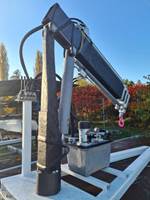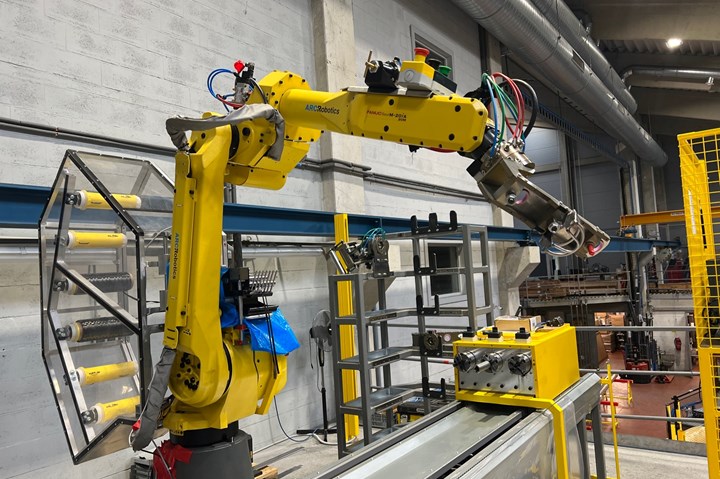CompoTech promotes automated filament winding machine options
Custom-built, turnkey automated winding and filament placement equipment create new possibilities for manufacturers to cost-effectively produce high-strength structural carbon fiber components.
New CompoTech automated carbon fiber winding machine with integrated FANUC six-axis robot arm. Photo Credit: CompoTech
CompoTech Plus spol. s.r.o (Sušice, Czech Republic) is highlighting its ability to now provide complete solutions from carbon fiber composite component design, prototyping and part production to process installation of custom-built, “turnkey” automated fiber winding and filament placement machines.
This development has been achieved through its investment in additional resources and formed links with specialist robotics and software supply partners, enabling CompoTech to custom design and produce in-house automated winding machines for manufacturers looking to invest in high-performance carbon fiber component production capabilities.
CompoTech introduces three new automated winding machine options:
- Compo FixTool: Fixed spindle and tailstock
- Compo AdapTool: Automatic tool length control up to 3m
- Compo LinAx: For larger parts up to 12m, with a robot mounted on linear axis rails
All of the company’s advanced winding machines are based on a “customizable” standard platform to meet individual customer needs and specifications.
CompoTech “turnkey” winding machines include an integrated FANUC (Rochester Hills, Mich., U.S.) M-20iA/20M with a R-30iB six-axis robot arm and remote controller unit, along with in-house developed “Shneg 2.0” fiber placement and winding software that controls the robot arm and winding mandrel. The software converts a design specification into a production program for the precise manufacture of carbon fiber components. Standard program preparation winding codes for producing common types of products, such as round tubes, beams and n-edge profiles, come with all machines, along with operator training and full system service and support.
CompoTech includes its proprietary axial fiber placement and winding technologies into its flexible and efficient automated production machines. For example, CompoTech’s placement technology, which uses graphite “pitch” as well as PAN fibers, is able to accurately place continuous fibers axially along the length of a carbon fiber-reinforced epoxy composite beam. The result is 10-15% higher stiffness in the axial direction and up to 50% greater bending strength compared to conventional filament winding.
The company notes its innovations create new possibilities for OEMs and Tier 1 and 2 component producers across industry sectors. “Companies looking to cost-effectively produce high-strength structural carbon [fiber] composite components for themselves can now do so using our technology in a custom-built machine,” Dr. Humphrey Carter, head of business development for CompoTech, explains. “We also work with our automated winding machine customers to help them develop the composite parts and design that can be manufactured most efficiently.”
CompoTech adds that its R&D team is looking at various advanced materials to process from the latest in resin technology and towpreg/thermoplastic tape placement to manufacture next-generation products, such as “linerless” hydrogen tanks for applications such as energy storage, aviation, HGVs and mass transportation.
Related Content
-
Plant tour: Spirit AeroSystems, Belfast, Northern Ireland, U.K.
Purpose-built facility employs resin transfer infusion (RTI) and assembly technology to manufacture today’s composite A220 wings, and prepares for future new programs and production ramp-ups.
-
Carbon fiber, bionic design achieve peak performance in race-ready production vehicle
Porsche worked with Action Composites to design and manufacture an innovative carbon fiber safety cage option to lightweight one of its series race vehicles, built in a one-shot compression molding process.
-
Plant tour: Joby Aviation, Marina, Calif., U.S.
As the advanced air mobility market begins to take shape, market leader Joby Aviation works to industrialize composites manufacturing for its first-generation, composites-intensive, all-electric air taxi.















.jpg;maxWidth=300;quality=90)

